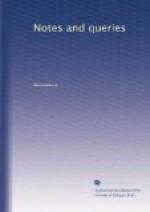Yet, in the English language there is, I believe, no work of this description; and I therefore beg leave to suggest, that your learned correspondents may contribute to a very useful compilation by furnishing illustrations, or references to illustrations, critical and poetical, collected from the most valuable authors, ancient and modern; and that this “sacred eloquence,” {458}
“Where’er ’tis found
On Christian or on heathen ground,”
if transplanted into learned pages, would to many readers, afford much pleasure. Meanwhile, I would refer Querist to the useful work of Camerarius on Symbols and Emblems.
“Do thou, bright Phoebus, guide
me luckily
To the first plant by some kind augury.”
The proverbial expression, “Under the rose,” appears opportunely in p. 214, beautifully illustrated[4], but still deserving further consideration. Schedius (De Diis Gemanis) and others have, with much learning, shown Venus Urania to be the same as Isis Myrionyma. With erudition not inferior, but in support of a peculiar theory, Gorop. Bacanus maintains Harpocrates and Cupido, son of Venus Uranis, to be one and the same hieroglyphical character. I shall now endeavour to explain the symbolism and dedication of the Rose. This “flower of flowers” adumbrates the highest faculty of human nature—Reason, and Silence, or the rest of the reasoning powers, which is indicated by the Greek term [Greek: epistaemae], science. (See Harris’s Philosoph. Arrang. p. 444., and Hermes, p. 369.). To whom, then, could the hieroglyphical rose have been more appropriately dedicated than Harpocrates, who is described with his finger pointing to his mouth—tacito plenus amore—a proper emblem of that silence with which we ought to behave in religious matters.
T.J.
[Footnote 4: Has “ARCHILAEUS”
looked for these verses into the
Rhodologia of Rosenbergius?
I have in vain searched for them under
“Rosae,” in the
Amphitheatrum sapientiae of Dornavius.]
“Where England’s Monarch” (No. 26. p. 415.).—The two lines inquired for are in Bramston’s Man of Taste, a poem printed about the middle of the last century. I need hardly add, that the poet was misinformed, it being well known that Charles I., when brought to trial, refused to plead or to take off his hat.
There is an account of Duke of Marlborough’s adventure with Barnard in the Gentleman’s Magazine, May 1758: but it may be the same as that in the Annual Register.
BRAYBROOKE
April 27.
Journeyman (No. 19. p. 309.).—“GOMER” may like to know that the old labourers in North Essex still speak of a day’s ploughing as a “journey at plough.”
BRAYBROOKE.
Sydenham or Tidenham.—I have no doubt as to Sydenham, included in the inquiry respecting Cromwell’s Estates (No. 24. p. 389.), being Tidenham; for this manor, the property of the Marquis of Worcester, was possessed by Cromwell; and, among my title deeds connected with this parish, I have Court Rolls in Cromwell’s name both for Tidenham itself and for Beachley, a mesne manor within it.




